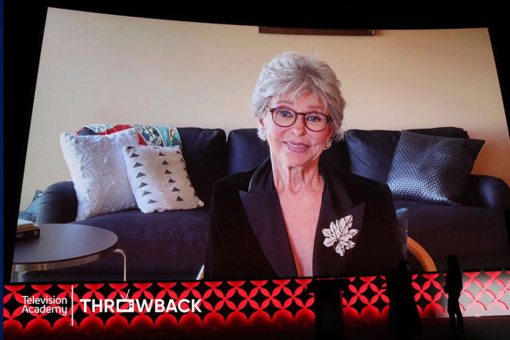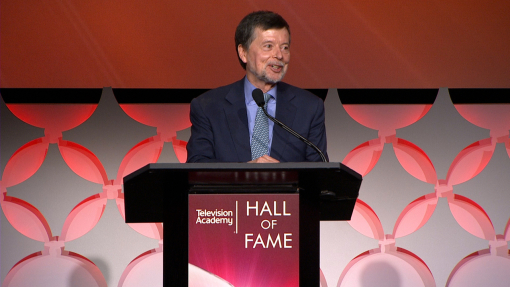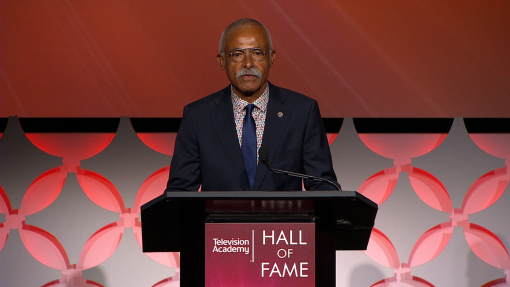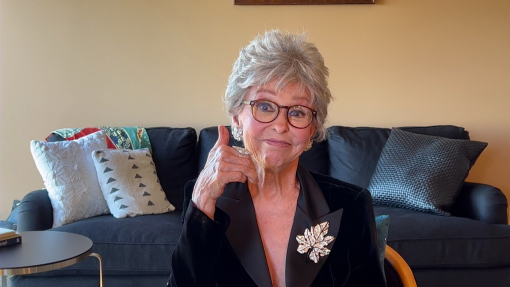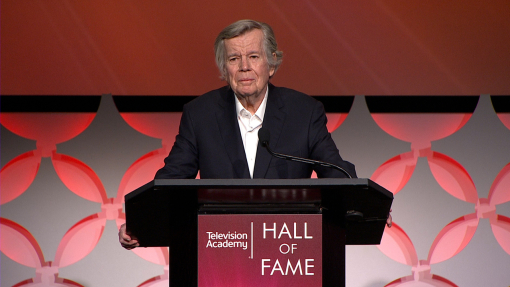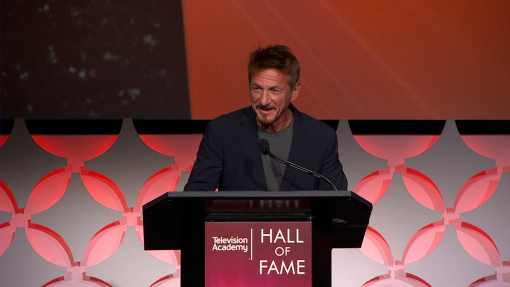The press has called her "ice queen,” “sex symbol," "businesslike," "alluring," "smart," "beautiful," "the most glamorous journalist on television,” "fanatically dedicated," “self-deprecating," "the shrewdest politician in the business," "tough feminist," "media darling," "a chameleon."
You get the idea that the press just doesn't know quite how to peg Diane Sawyer, but is hell-bent on trying. Defenders praise her erudition, professionalism, dedication and principle. Detractors criticize her for sometimes training her big intellectual guns on tabloid waifs like Tonya Harding or American monstrosities like Charles Manson.
It's a little strange that there is so much debate about Sawyer, who is, quite indisputably, one of the consummate television journalists of modern history. She's right near the top of that rarified group of personages who are practically one-man (or yes, one-woman) media organizations: Rather, Brokaw, Jennings, Koppel, Wallace, Pauley, Walters.
But for some reason, Sawyer seems to attract conjecture. Perhaps it's her background with former President Richard Nixon (she calls it her "Scarlet 'N'”), which made her suspect, notably to Dan Rather, when she was first hired as a reporter for CBS in 1978. Perhaps it's her star-like photogeniality (she was, after all, America's Miss Junior Miss — also known as America's Young Woman of the Year — at 17). Perhaps it was her initially distant, no-nonsense persona on CBS. Maybe it's her "celebrity marriage" to director Mike Nichols. Maybe it's her rumored rivalry with Walters (they both deny it). Maybe it's that flaxen hair. Or maybe it's the fact that Sawyer recently went on Oprah and confessed that she likes to loll around the house in her husband's clothes.
Or maybe it's just that this is one remarkably multi-faceted, unusual human being.
In any case, it all seems to underscore Sawyer's motto, found on the wall of her ABC news office: "WE'RE THIS/AND WE'RE THAT/AREN'T WE?" As she once explained to interviewer Rick Marin, "That, to me, is journalism. It says we're one thing and we're the other thing. And the question mark at the end — that's a good journalist, too." So maybe all the fuss stems from the fact that Diane Sawyer is just so many other things (isn't she?).
For one thing, she is a Famous Louisvillian (as in Kentucky), so the Internet reports, in the jarringly eclectic company of Muhammad Ali, Colonel Sanders, Thomas Edison, former U.S. President Zachary Taylor, Louis Brandeis, and vibraphonist Lionel Hampton. Born in Glasgow, Kentucky to county judge E.P. Sawyer and his elementary school teacher wife Jean (nee Dunagan), young Diane earned a B.A. from Wellesley College and flirted with law school at the University of Louisville for one semester before turning to a career as a broadcast journalist. Her first broadcasting job? At WLKY-TV in Louisville, where she delivered downright poetic weather reports. Literally. Possibly seeking to underscore the lyricism of nature. Sawyer decorated her forecasts with the verse of Emily Dickinson. (Where are those tapes?)
It's unlikely that this work was terribly fulfilling to the likes of young Diane. In any case, she left in 1970, after three years, to work for … the President of the United States. Right. From weathergirl to White House. It was a natural progression, really, when you consider that her father was a politically active Republican, and family friend Lamar Alexander worked for President Nixon. Sawyer took a job as assistant to an assistant — working for Deputy Press Secretary Jerry Warren, who worked for Press Secretary Ron Ziegler.
Her first encounter with the chief executive wasn't exactly poetic. "The first time I met the President," she told fellow Hall of Famer Oprah Winfrey, “I was tearing down stairs to the situation room, with scissors in hand, and I came downstairs, around a corner and I flattened him. The secret service scooped me up, scissors in hand. And he was so wonderful; he looked up and said, ‘You could get hurt this way.’”
The relationship improved. Phone answering and press release work gave way to ghostwriting a magazine piece for Nixon about his mother. Such was the President's approval of the article that he took to referring to Diane, for better or worse, as "the smart girl." When Watergate hit, press aide Sawyer helped close ranks, staying indefatigably tight-lipped and loyal, "a total non-source, close to the cuff," Dan Rather was to later say, in tribute. And she was certainly in the thick of things. When John Dean went to deliver his damning testimony to Congress, it was Sawyer who was asked to research a rebuttal to Dean's allegations of a White House cover-up. In the end, Sawyer became Ziegler's most trusted aide, and one of Nixon's as well, flying home on the plane with him to San Clemente. There she remained for four years, helping with the exiled former President's memoirs. The politics of the situation were secondary. As Sawyer put it, "When someone's life is shattered, there is only humanity." Of course, she also acknowledged having a sense of being a minor part of "Shakespearean, dark history." (We’re this, and we’re that again.)
In 1978, Sawyer pulled off one of the most dazzling career changes since Ronald Reagan ran for governor of California, or Wilt Chamberlain took up boxing. She managed to parlay her historic credentials into a shot at journalistic credibility, landing a reporter's job with the Washington bureau of CBS News. Going from the Nixon White House to the deeply anti-Nixon Washington press corps was roughly like Marie Antoinette's lady in waiting trying to join the French Revolution. Yet any objectivity problems — despite the grumblings and suspicions of some colleagues — never materialized. Sawyer proved utterly professional, and singularly driven, in short order becoming State Department correspondent, with stories appearing regularly on the CBS Morning News and Walter Cronkite's Universe.
In 1981, she joined Charles Kuralt in hosting the weekly version of Kuralt's brilliant Sunday Morning. The Kuralt-Sawyer co-anchor team of the CBS Morning News, which lasted until 1984, was undoubtedly the most sophisticated and literate in history (which, ironically, probably contributed to its lagging ratings). There has never been a more consistent presentation of intelligent, charming morning television journalism, and Sawyer dedicated herself to the task.
"She works like a demon," media critic John Katz, Sawyer's Morning News producer, told TV Guide in 1984, “And she is smart. She's also phenomenally skilled at maneuvering through the very tricky waters of television politics. But it's not like she simply got the money for being charming. Unlike a lot of these people in television news, she's done the work.”
Sawyer, in fact, navigated those tricky waters right into journalism history, becoming the first woman correspondent for 60 Minutes in 1984. During the next five years, Emmy nominations piled up as she honed her investigative technique, and 60 Minutes seemed to be her permanent home, if not the pinnacle of her career. Well, hardly, as it turned out. In a shocking move, Sawyer left the venerable program to co-anchor a new show, Prime Time Live, for ABC in 1989 — for an obese $6 million per year. And get this; she turned down an offer of $10 million from Fox! Why? Simple. She wanted to work at ABC, and liked the job better! In the avaricious world of celebrity salaries, a decision like that must have seemed almost demented, but for Sawyer, it was a matter of quality of job over quantity of money.
Then it happened all over again in 1994, when her contract was renegotiated to $7 million, and she reportedly turned down even more lavish offers. Said her husband, "She didn't want to be swayed by the wrong thing. She gave up enormous amounts of money without blinking." Sawyer's own comments about her salary, to USA Weekend Magazine, almost suggest embarrassment at her paycheck: “I think most people think the money is an amazing unintended consequence of a marketplace we don't fully understand … We all say, ‘Good heavens! How did this happen? How did we deserve this?’ Other professions deserve so much more ... We all know we don't deserve as much as a great teacher or, in my mind, a great plumber … The gratitude you have when a plumber comes quickly when your toilet is overflowing … should be matched with dollars.”
It's true that Prime Time Live was initially far more lively than anyone wished, with apparent friction between Sawyer and Sam Donaldson that was perceptible even to casual viewers. (Donaldson is on the record that the problems were in format, not personality.)
Prime Time went on to become one of the most vigorous news magazines on the air, and Sawyer continued to distinguish herself as one of television's most relentlessly probing — yet always engaging — interviewers. Much of her work has been nothing less than history-making. Here are a few of her "greatest hits," season-by-season:
1989-90: Sawyer co-anchored a special live broadcast from the White House, joining President and Mrs. Bush for a tour; co-anchored an unprecedented hour-long broadcast from inside the Kremlin; did an award-winning investigation of the bombing of Pan Am Flight 103.
1990-91: Sawyer exposed patient neglect at a Cleveland, Ohio Veterans' Administration Hospital, winning the prestigious Robert F. Kennedy Journalism Citation; conducted the first interview with Saddam Hussein granted to the west in ten years, just prior to the Gulf War; conducted the first interview with former Soviet Foreign Minister Eduard Shevardnadze after his resignation; became the first American TV journalist to tour the KGB headquarters in Moscow.
1991-92: Conducted an award-winning hidden-camera investigation of racial discrimination, documenting the different experiences of blacks and whites in America; did an undercover investigation of unsanitary daycare centers (which won the National Headliner Award); investigated poor mammography equipment in the U.S.; secured an exclusive interview with Patricia Bowman, who accused William Kennedy Smith of rape.
And the "hits" just keep on coming. More recently, Sawyer has interviewed Fidel Castro, Manuel Noriega, President and Mrs. Clinton (in their first post-election interview); exposed fraud in the diamond industry; blown the lid off of waste and bloat in public school bureaucracies; pulled off a shocking investigation of errors in prescription medication (by sending 100 prescriptions to drugstores, then tallying up the mistakes) exposed telephone con artists who victimize the elderly; spent two nights inside a maximum security prison for women, just to document conditions; talked with Robert McNamara in his first broadcast interview about the Vietnam War.
In short, Sawyer, who has also ably substituted for Peter Jennings on World News Tonight and the redoubtable Ted Koppel on Nightline, is the antithesis of that ubiquitous journalistic anathema, the TV talking head. She is ardently hands-on — passionate is the raging cliché that would apply here — often researching and rewriting her own scripts, and fighting for story ideas (the pieces on "Washington Waste" and "Welfare Mothers" were hers). Socializing is a casualty of her work obsession; the woman divides her days solely between home in Connecticut, and office. And office, of course, can be anywhere from Uruguay to Uganda.
"I'm gone two or three days a week," she told Oprah Winfrey. "I've gone to Cambodia or Afghanistan on the weekend."
Right. Lest anyone think the life of a big-time TV newswoman is all perfumey Dior suits in nice sound stages, consider a recent Sawyer trek to Africa. Would even Dan Rather, he who professes to love the road, have stood for this?
"I was in Uganda once, and we were trying to find the epicenter of HIV, where one out of three people is HIV positive," Sawyer told Winfrey. “There was no place to stay, so we stayed at a bus stop. On a cot. I'm lying on a cot, with roaches the size of hamsters all over me. I put a flashlight under my chin, just to keep them off my face. I wrapped my shirt with dental floss. I thought, if they're not in my eyes, I'm okay … I thought, ‘Tell the folks back home that this is what I do.’"
Sawyer's image, deservedly, is that of an ink-in-the-blood (video-in-the-blood?) journalist. But here comes her this, and that credo again. It would be a disservice to neglect reporting that she is also a mushy, push-over romantic, with some genuinely eyebrow-raising quirks — many of which she revealed for the first time on Oprah. Here's a glimpse into her frivolous side, uncovered as only Winfrey could:
Favorite things: "Cloudy days, songs about unrequited love, rice pudding. Cloudy days because I don't have to go out and do anything."
Favorite vacation: "Rolling from one side of the bed to the other."
Favorite memory: "Somebody once said that the greatest action of romantic love is to pay deep and undivided attention, and I think there was a moment with Mike at a dinner when he just looked at me and said nothing, and I said, 'yes,' and we just knew."
Which brings up the fact that she first became a blushing bride in 1988, at 43. (Her friend Joan Ganz Cooney told Vanity Fair, "For a certain kind of woman, it is essential that they be fully developed before they can marry.") She and Nichols met in a Woody Allen-like moment at the Paris airport, when Nichols ambushed Sawyer from behind a potted palm, announcing, "You're my hero." Sawyer replied, "And you're mine." They arranged to have lunch to discuss mutual heroism, and the possibility of Nichols doing 60 Minutes, but Sawyer knew her interest ran deeper:
"In the first 90 seconds, I knew, and nothing fundamentally has changed," she said in a Vanity Fair piece. "It's like the tonic chord; when you get there, you know you're there — there's no explaining it. Not that anyone thought it was going anywhere. But I certainly knew he was at the center of the dance."
Their lunches weren't exactly marked by ephemeral discourse; light movie-and-sports fare. At one, Sawyer began quoting Thomas Mann in German (somewhere in her youth, she spent a year living in Germany) — specifically, a line about how the one who loves more is the underdog and is destined to grieve. Nichols, who was born Michael Igor Peschkowksy in Germany (he and his parents fled the Holocaust in 1939) and is fluent auf Deutsch, was duly impressed. "True love made Pinocchio a real boy," he told Vanity Fair. "It really happened, because she loves me and accepts things about me I can't imagine anyone accepting." Of course, he had to get used to the fact that Sawyer (as she told Oprah), harbors a secret desire to be a lounge singer, and wears Nichols' clothes — underwear included — on weekends. (She pleads being unable to find her own.)
There's another little quirk about Sawyer that cannot be ignored. She never thinks she has quite arrived, and is always looking for the next big step. There have been recent rumors of her being wooed back to CBS to replace Rather, but, as she announced, "nothing has been discussed" and "I'm doing nothing but work at ABC that I love." Still, she allows that it "would be wonderful to see a woman in one of those jobs."
For now, the one-time Junior Miss must be content to remain one of the senior-most respected broadcast journalists in the country. And, of course, she's still: an ice queen, sex symbol, businesslike, alluring, smart, beautiful, the most glamorous journalist on television, fanatically dedicated, self-deprecating … and this and that. (Isn't she?)
"I can't imagine doing anything else," she told TV Guide. “The happy moment when you're on the plane and you've been grouchy and you've finally got all your papers put away and you open the folder and start to read about the thing you're going to do. And you can feel its pulse. And you start to imagine ways that it's going to be on the air. And you think about reactions people are going to have to what you're going to tell them. That's joy.”
Isn't it?
This tribute originally appeared in the Television Academy Hall of Fame program celebrating Diane Sawyer's induction in 1997.

